The weather changes affect people all over the globe. In some areas people may lack enough rain, other areas may have excess sunlight leading to drought, in yet other areas the seasons may get more extreme and severe. Winter storms in this case may be as dangerous and life threatening as the summer storms. You should be aware of how to be well prepared for extreme and unexpected emergency situations. The better you’re prepared the less panicked you and your family will be.
[the_ad_placement id=”in-text-1-type-r”]Following along with the tips and advice we’ve compiled, make a checklist and stick to it. Don’t ignore some tip just because you’re sure you won’t forget it when the time comes. Write down all that is included here and you will be glad you did.
You need to consider many factors, and in order to enjoy winter be sure to take all precautionary measures listed here. Don’t rely on memory, but on well-organized list of tips.
How to prepare your house for the winter
First and foremost you need to winterize your house or apartment where you live. This is your safe heaven and if you need to take shelter immediately, this would be the perfect place to fully rely on:
- Check the power supply and make sure it’s in top condition. In case reparation is needed, do it months before the winter season.
- Insulate the windows, doors, walls and attic. Provided where you live, city or countryside, winterize all buildings that give shelter to either you, your family or farm animals.
- Keep the chimney and fireplace (or stove) clean. If it’s not inspected for objects stuck there, you risk suffocating.
- Don’t block pipe faucets. Let them drip a bit of water. Thus, the pipes won’t freeze thanks to running water. Alternatively you can tape heat tape around the pipes.
- Keep good maintenance of any alternative heating sources and read the safety labels.
- Check the roof’s strength in case of heavy snowfall. Too much snow may get quite heavy and if the roof isn’t secured for such situations, it may endanger the habitants and collapse.
- Store some food that can last long, like canned food. Plan ahead so that it can be enough for you and your family in case you’re blocked in your house for a long period.
- Keep at least one or two torchlight at hand in case of power outage. Turn off all appliances and light. Alternatively, keep only one light on, so you know when the power is back.
- Also keep the fire extinguisher close at hand. Appliances may overheat, candles may burn or fire may start while you cook. Most fire accidents happen during the winter season. Check the fire alarms and change their batteries. Keep extra batteries.
- Prepare your emergency kit and check if it contains all necessary tools – we have a great piece on how to put together a survival bug out bag.
One important part of your house preparation is if you plan on using a generator. It is a good alternative powering method, but there are several safety tips you have to be aware of:
- The best advice is to let a qualified person install the generator for you.
- Most important is to keep the generator outside.
- When you need to change the fuel, either detach the fuel tank, or turn the generator off. Let it cool properly, and then add the fuel. But before changing the fuel, always make sure the generator is cooled. If the running or hot generator gets in contact with fuel it can cause explosion.
- Never overload your generator. Read the manual and always follow the instructions that come along with it. If not, the generator and the appliances using its power may get damaged, and that may even cause fire.
In the end, we can recommend the best portable generator that will keep your home warm during the winter in case the power goes out.
You should always be extra careful when using generators, grills, stoves, and other gas-burning devices. These include blocked chimneys, automotive exhaust fumes, gas-based heaters, etc. They release carbon monoxide, which is a silent killer.
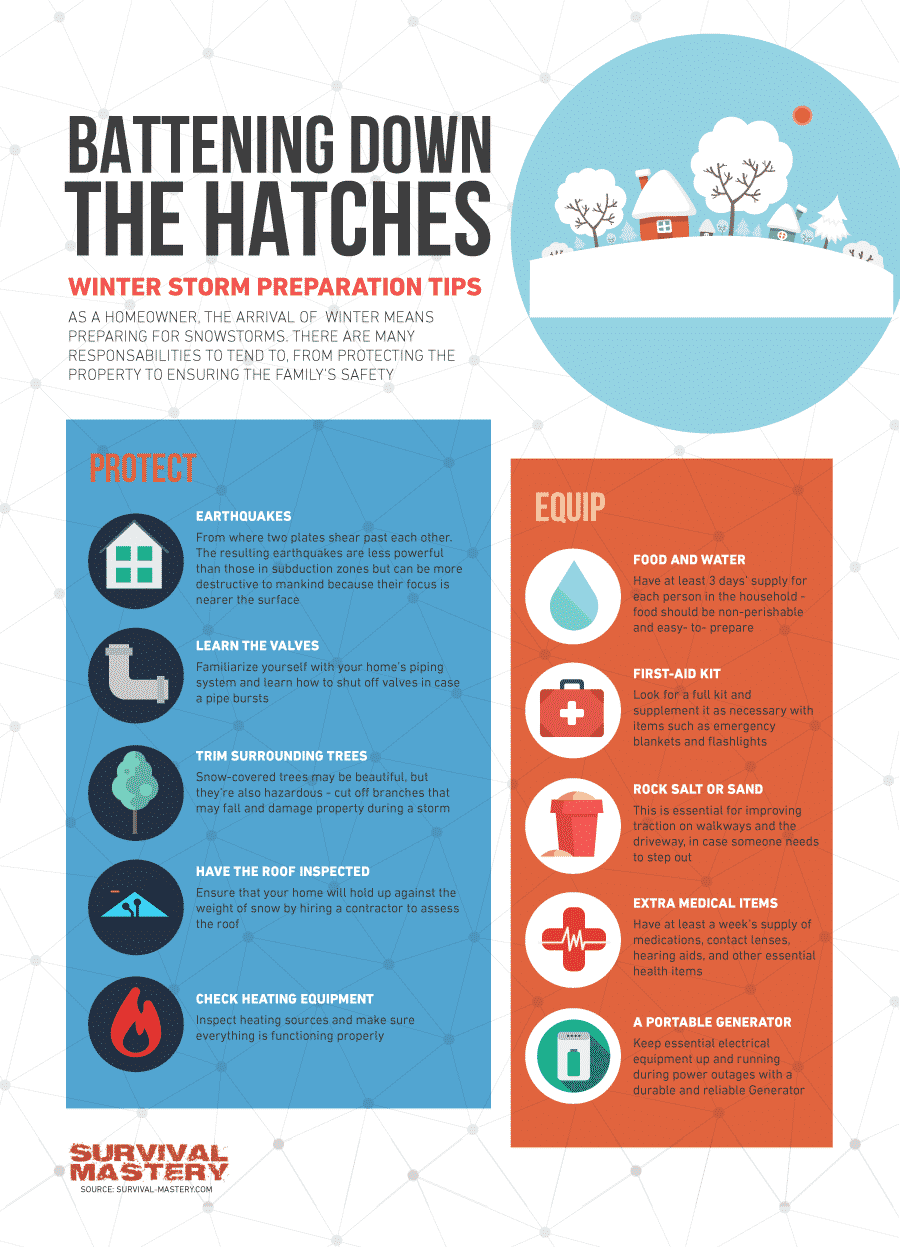
It is an odorless gas and kills thousands of people especially during the winter season, when these appliances are used indoors. And also always check the batteries on your carbon monoxide detector to make sure you can safely rely on it in case the gas has been detected.
Prepare your car appropriately
Along with preparing and winterizing your house, you need to take care of your vehicle too. It may be of extreme importance in case of emergencies and your car needs to be able to handle the rough winter conditions.
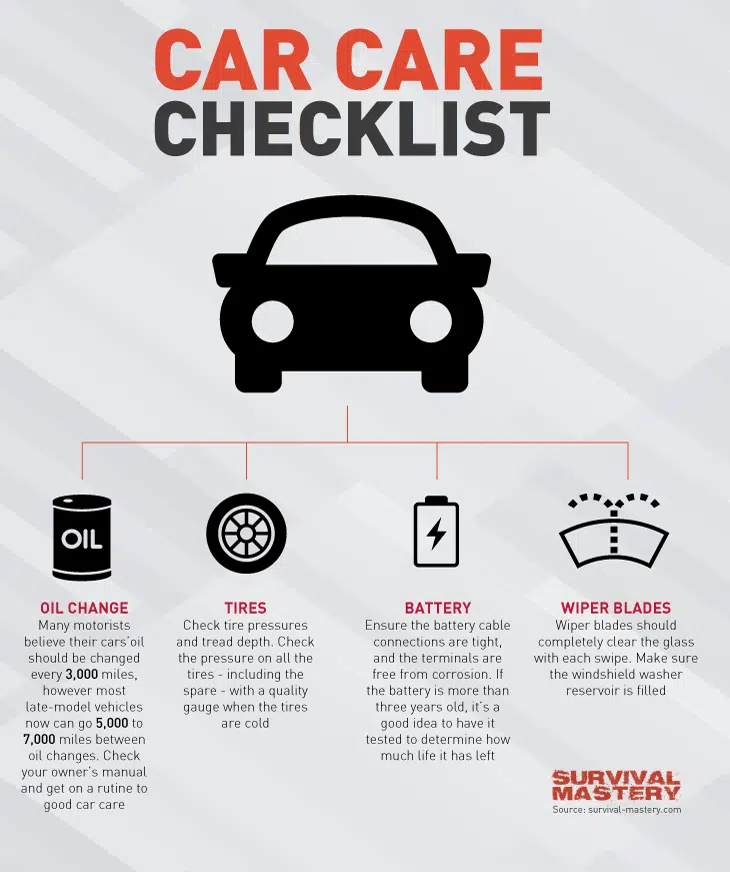
This applies also in situations when you need to travel. Your car needs to be in top shape.
- Check the tires and be prepared with all weather tires or winter tires;
- Check the antifreeze level and radiator;
- Check the gas tank and make sure it’s full;
- Be prepared with a wintertime formula for the windshield washer.
In case you get stuck on the road, you need to be prepared with blankets, food, water, flashlight, sand, radio and batteries for it (make sure the radio is battery-powered), first-aid kit, dry and wet soft tissues for sanitation and plastic bags for the garbage. You can find out more about how to be prepared from our detailed article on car safety kit.
Be prepared when outdoors
Winter can catch you unawares any place at any time. No matter if the weather forecast warns about an upcoming blizzard or not, you need to have some basic precautionary measures in mind:
- Make sure you are always prepared with the appropriate clothing, hats, boots, mittens, gloves, socks, scarves;
- Prepare crampons for you and your family members in cases of freezing rain and sleet, frozen pathways, streets and sidewalks. Not all areas in the town/city can be safely secured;
- Secure the garden pathways and sprinkle salt or sand on frozen areas to avoid falling and causing bone fracture;
- Before leaving the house, check the weather conditions and forecast, in order to be always up-to-date with the situation. Weather can change abruptly. Don’t leave the house if the forecasters warn against it and if a storm is coming; you should actually be prepared for the storm and you can read more about it here.
- When outside doing chores, work with caution and don’t overload yourself, always carry a cell phone;
- If windy, make sure you wear wind- and waterproof clothes;
- Use the shovel to not only clean the pathways, but also the roof edges. Remove any icicles and hanging snow that can endanger you or your family. Never attempt to clean the roof alone. Always do it with a friend or neighbor. Ask them to help you by holding the ladder while you climb up. Instruct all your family members not to approach the house or leave it while you’re cleaning the ice and snow.
Special safety tips for children and infants
Children and infants are always more fragile than adults and need special care and attention. Some important safety measures must be undertaken to ensure your children are safe and warm:
- First and foremost, good clothing to keep the children warm and dry. Always dress kids with one extra layer than normal for an adult in these conditions.
- To avoid hypothermia, make sure you follow these rules – the clothing’s inner layers should allow the skin to breathe and remain dry. The outer layer should be wind- and waterproof. The inner layers can be made of Lycra (for the skin to breathe and stay dry) and wool (to keep the child warm).
The boots and mittens should also be waterproof, the socks best be made of wool. This is so, since children play with snow, they tend to get wet more quickly than adults. If you suspect your child suffers from hypothermia, move it immediately in a warm environment and change it’s clothes with dry and warm ones. - To avoid frostbite, the child must keep its face covered all the time. It is imperative to keep the mittens on while outside. You can recognize frostbite by the paleness of the area. The child may report the area itchy or numb. Immediately take the child inside, give it warm drink and clothes. If the affected area doesn’t get back to normal within 10 minutes, call a doctor.
- When the child has contact with other children and people, at school or playing outside, viruses and flus may spread quickly. Teach your child to sneeze and cough in a tissue or the bend of the elbow, to prevent the bacteria from spreading around. You can also visit the doctor to get your child a preventive vaccine.
- When playing outside make sure your child wears a helmet. Whenever you can, accompany your child to its playground and attend to it in case of emergency. If you can’t always attend it, set time limits and instruct your child to come home regularly.
- Never leave a child unattended when ice-skating. The child must always wear a helmet while ice-skating. Even sledding can go out of control, so you should always supervise your children, especially if they are young.
- Avoid overcrowded sledding areas. And don’t forget to keep the sled sound and safe. Don’t buy a sled with sharp edges.
- Give your child a cell phone so he/she can contact you immediately in case of emergency. Instruct your child how to use the cell phone and make it as easy as possible for the kid to call you.
- If possible always accompany your child to school. Never leave it alone, especially in extreme winter conditions such as storms, sleet, windy conditions, extreme cold, fog, heavy snowfall. When vision is impaired by low visibility conditions, the child can get lost, fall or be unable to determine the distance from one object to another. Severe accidents may occur.
General safety tips during winter storms
One very important rule of thumb is when you plan to leave the house to check the weather report beforehand. One of the best weather forecast sources is NOAA. If you have internet, check the website regularly, before anyone of your family members plan to go outside. If there’s power outage, tune your radio on NOAA Weather Radio (the best weather radio will be of great help in such case). Other local radios can also be helpful, if their main source is the National Weather Service.
[the_ad_placement id=”in-text-2-type-r”]Never leave animals and livestock outside, unprotected and without safety measures. Make sure they have access to ample amount of food and water. Check there’s no risk for fire or freezing inside the shelter. Prepare such shelters beforehand to avoid complications during a storm or blizzard.
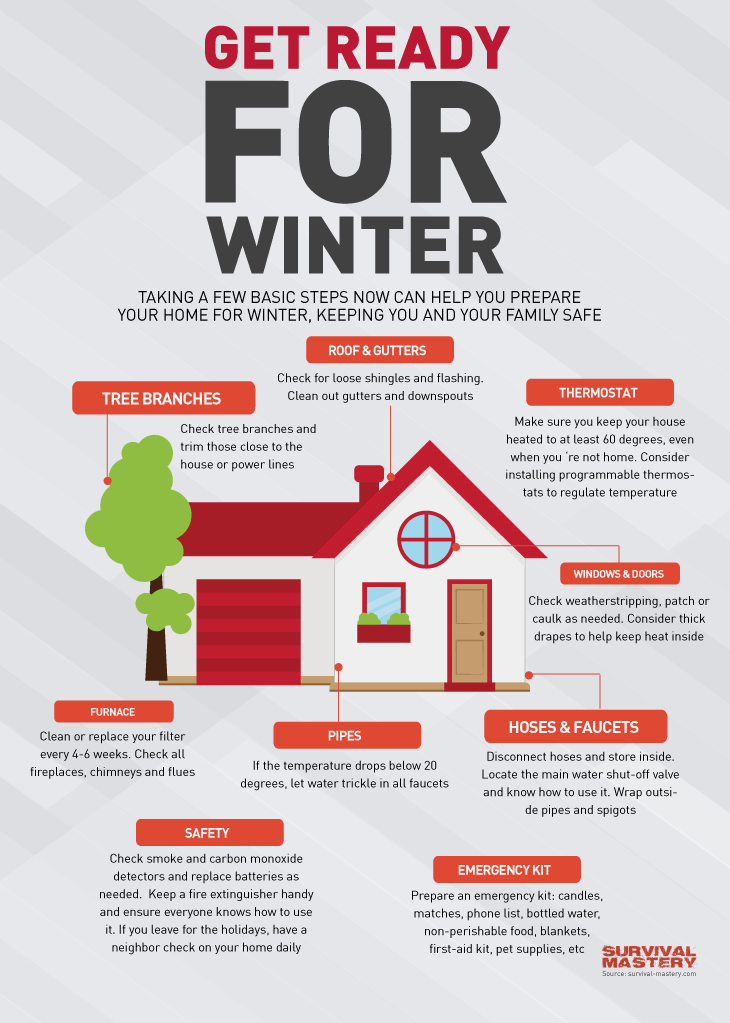
Even if you plan on a trip during the winter season, keep the house warm while you’re away. Set the thermostat to a moderate temperature (ideally around 55 degrees Fahrenheit) to prevent pipes from freezing. Damage inside the house may cost you much more than a higher bill, so don’t compromise your safety.
It is wise to check which are the appointed buildings in the town, for emergencies. This is in case you have no access to your home, there’s power outage or the heating system failed during extreme cold. This is strongly advised for long periods of extremely low temperatures.
What if winter storm catched you during travel?
It is always advisable to avoid traveling during the winter season. Transport isn’t reliable, weather conditions can worsen, the roads and airports can become dangerous places, and as a result serious accidents can occur.
- If you can, avoid long travels. If you have booked flights, cancel them.
- If you absolutely must travel, it is highly advisable to inform family members, close friends or neighbors of your plans and route, and when you come back home. Also, ask them to check your house regularly when possible and contact you if something needs your immediate attention.
- If you travel by car, and become blocked or stranded by too much snow, make sure that:
-
- You don’t leave the car while waiting for road help;
- Move your body, arms and legs regularly;
- Keep the lights inside the car on, in order to be visible and to help rescuers locate you easily;
- Do not run the heater and engine for too long. Set an hourly time limit, for example, keep the heater on for 15 minutes every hour;
- Before you go on your journey, check that the tailpipe is clean and unblocked. When blocked in a snow storm, try to keep the tailpipe unblocked by snow. Gas fumes inside the car can be fatal.
- If you have pets, the best option is to give them to friends or neighbors. If none of them can take care of the animals, give them to a reliable pet shelter. Make sure the shelter can provide all warmth, food and water no matter the winter conditions
- Bring along winter car kit for emergency situations. Make sure it includes phone charger, shovel, led flares, windshield anti-freezing formula, first-aid kit.
Winter can be a long awaited season by children, and snowboard and ski enthusiasts, but it can also turn fatal for those unprepared for extreme and seemingly unexpected conditions. Weather forecasts always warn and send alerts to the general public but you have to always stay tuned to the appropriate radio stations, TV channels or internet websites.
[the_ad_placement id=”in-text-3-type-r”]The beauty of such extreme conditions is that if you’re well prepared you can enjoy even the tough moments, unless they turn into national crisis. And again, if these measures are considered and people are prepared, crisis can be avoided.
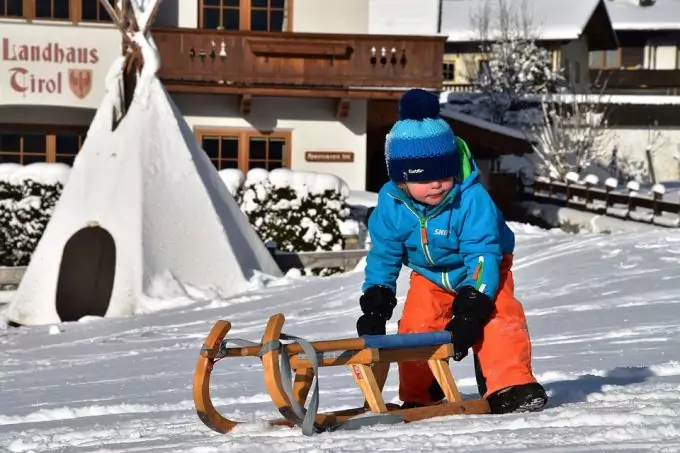
To sum up the main points
Never ignore the weather reports and alerts. Prepare your house and vehicle for the worst-case scenario. Take extra care for the elderly and children in your family or very close friends and neighbors, don’t ignore those in need. Be prepared with extra food, that is already cooked or packaged, and check the water supply, to avoid dehydration in case of critical moments.
Be careful with all gas-powered appliances and never run them indoors. Do not leave the house during days-long blizzards. In this situation, use sparingly your food supply to avoid running out of food too quickly.
If these tips are carefully followed winter doesn’t have to be dreadful, and incidents can be easily avoided.



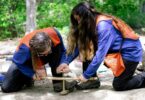
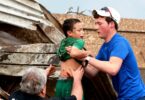

I have some additional tips for your readers.
1. I have a set of tires that I have wrapped some chains on. I find that this provides better traction than snow tires, especially outdoors. This set-up also works for muddy trails.
2. I have a habit of stocking up on salt to melt the snow faster.
3. You can build your own snowplow by affixing a couple of snow shovels to your bumpers. Just make sure that they are connected firmly. The only problem I encountered was when I ran over some big rocks which displaced the shovel.
Thank you, Kevin! These are really helpful.
If a snow storm is bad enough in the morning, wait it out. If it doesn’t get better, call your job and your children’s school to notify them how bad the weather is instead of going out and risking it. Some disasters aren’t made equal for most people. You can walk through a storm and still arrive safely or you can wait out inside your car and still be hit. Stay safe and stay warm in the coming winter!
Hi Mikayla,
Knowing the situation out there is important, but you must first winterize your house.